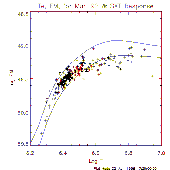
 |
Documentation > SXT Observation Notes > this page |
Image name: Reason_4_Te_EM_Correlation.png (click image to enlarge)
Image size: 6.17500 KB (512x512)
Date submitted: 22-Apr-1996

4/22/96, LWA
PROBABLE REASON FOR CORRELATION BETWEEN TEMPERATURE AND
EMISSION MEASURE IN SXT LOW-TEMPERATURE MEASUREMENTS
Wolfson, Acton and Datlowe (Solar Physics, 59, 373, 1978) discuss a problem
which I believe is analogous to the Te, EM correlation seen in SXT analysis
of low tempeature situations. In the 1978 case we were observing active
regions with the Mapping X-ray Heliometer (MXRH)on OSO-8. The MXRH was like
SXT in that it was much more sensitive at higher plasma temperatures. When
the MXRH proportional counter spectra of small flares in active retions were
reduced the emission measure was observe to DECREASE at the beginning the
flares.
Wolfson's paper demonstrated that the much stronger signal from the small
amount of flare plasma so dominated the MXRH count spectrum that the larger
emission measure of the background active region was effectively lost. Only
when the active region signal was subtracted from the flare signal could a
proper emission measure for the flare be derived.
For the SXT full-disk observations we have a similar situation. Even though
the emission measure of the cool corona might be larger than that from the
hotter active regions it can be "masked" by the much larger active region
signals. This will produce an apparent decrease in total emission measure.
The figure demonstrates the remarkable agreement between the Te, EM curve for
about month's worth (8-MAR-92 00:57:46 to 11-APR-92 17:47:47) of SXT
measurements and the sensitivity curves of Al.1 and AlMg.
To test my hypothesis further I've used the SXT software to "observe" 3 model
coronas.
Model Log T EM
Cool corona 6.1 10
Active region 6.7 1
Combined 6.1 10
6.7 1
for these 3 model coronas the SXT would have returned the following
measurements through the Al.1 and AlMg filters.
Before first entrance filter failure:
Model Log T EM Al.1 AlMg
(DN) (DN)
Cool corona 6.10000 10.2920 38.4816 13.5577
Active region 6.70000 1.02920 269.175 156.955
Combined 6.56065 1.56040 307.657 170.513
After second entrance filter failure:
Model Log T EM Al.1 AlMg
(DN) (DN)
Cool corona 6.10000 10.2920 77.6740 25.1125
Active region 6.70000 1.02920 321.450 183.970
Combined 6.47838 2.23163 399.124 209.082
The results are encouraging in that the proper temperature and emission
measurements werre returned for the case of the cool corona and active
region. The combined model demonstrates quite clearly how the smaller amount
of hot material "masks" the cooler plasma. This is especially true before
the two entrance filter failures increased the low temperature sensitivity of
the SXT.